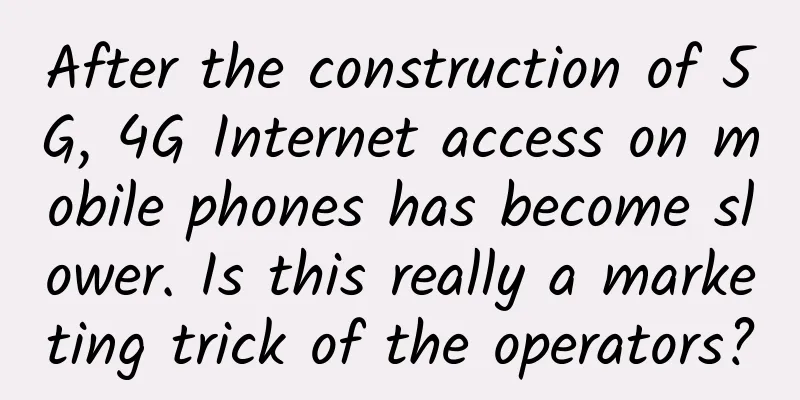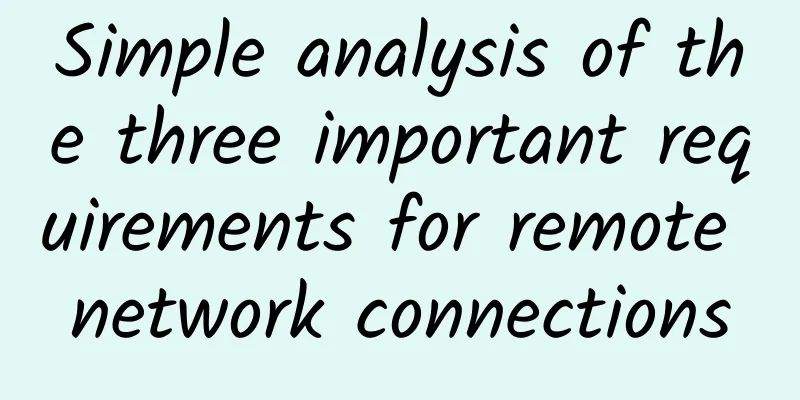After the construction of 5G, 4G Internet access on mobile phones has become slower. Is this really a marketing trick of the operators?

|
Preface Recently, many customers and friends have asked me, "My mobile phone 4G has been very slow recently. Has the operator limited the 4G speed in order to promote 5G?" Based on my many years of work experience, this situation is unlikely to happen. Viewpoint In recent years, mobile Internet has developed rapidly, and users' food, clothing, housing and transportation are closely related to mobile Internet. However, due to the limitations of 4G base station bandwidth, frequency resources and other factors, the traffic demand of a large number of 4G users cannot be met. Insufficient capacity is one of the bottlenecks facing the current 4G network and is also the main reason for the slowdown of 4G network. Mobile Internet 1. Basic structure of 4G base station antenna 4G Antenna Usually, the antennas of 4G base stations are built on the outer edge of the tower or the roof of a building. The picture above shows a 4G antenna on a tower. Usually, the antennas on the tower are groups of three, and each antenna covers a fan area of about 120° slanting downward. Base station antenna Key points: The area covered by these antennas is called a sector in communications. Usually, one antenna emits two radio waves of different frequencies, which we call carriers. The combination of sectors and carriers constitutes the smallest service unit accessed by UE (user equipment), namely the cell. 2. What is the capacity of a single 4G base station? Taking the 4G FDD system network as an example, when conducting capacity planning, the number of users that can be accommodated in the cell during busy hours is usually calculated based on the throughput demand of each user per hour and the cell throughput obtained through simulation or testing. The number of users that can be accommodated in each base station is then obtained based on the configuration of each station. FDD capacity planning calculation From the above figure, we can see that if calculated based on the cell bandwidth of 20Mbit/s, the number of users supported by a single cell is 1002, while the number of users supported by a single base station reaches 3006 (the number of users supported by a single cell multiplied by 3). 3. Mobile Internet grew rapidly, and the average monthly traffic (DOU) increased steadily Online and offline service integration and innovation remain active, and various Internet applications are accelerating their penetration into users in fourth- and fifth-tier cities and rural areas, which has kept the consumption of mobile Internet access traffic growing rapidly. In 2019, the consumption of mobile Internet access traffic reached 122 billion GB, and the average monthly mobile Internet traffic per household (DOU) reached 7.82 GB/household/month, 1.69 times that of the previous year. Among them, mobile Internet traffic reached 121 billion GB, an increase of 72.4% over the previous year, accounting for 99.2% of the total traffic. Statistics chart of national mobile Internet traffic in 2019 by the Ministry of Industry and Information Technology The average monthly traffic of 4G users in 2019 was more than 39 times that of 2014. Since the physical resources of each base station cell are limited, the more users access the Internet at the same time, the fewer resources are allocated to each user, and the slower the Internet speed will be. 4. From 2014 to 2019, the growth rate of 4G users far exceeded the speed of base station construction From 2014 to 2019, the number of 4G users in my country increased from 97.284 million to 1.28 billion, an increase of more than 13 times, while the number of 4G base stations increased from 850,000 in 2014 to 5.44 million in 2019, an increase of only 6.4 times. The growth rate of 4G base stations is significantly lower than the growth rate of 4G users. In addition, the population distribution in the east and west of my country is uneven, and the population density in the eastern coastal cities is much higher than that in the western regions. Therefore, the capacity of a single base station tends to be saturated. Base station shelter After 2019, due to the needs of the national 5G strategy, operators will focus their main efforts on the construction of 5G base stations, slowing down the construction of 4G base stations, and the problem of slow Internet access for 4G users will become more obvious. 5. Can the problem of slow network be solved by increasing 4G base station coverage? The capacity of a single base station is limited. If more 4G base stations are built, can the Internet speed be increased? The answer is no. The more base stations there are, the better the signal coverage will be, but the signal quality may decrease. Multiple antennas should be planned with reasonable angles Due to the 4G technical standards, when multiple 4G base stations overlap, three adverse effects will occur: low SINR (interference within the network), low cell throughput, and poor user perception - all of which will cause users to perceive 4G Internet access as very slow! There are three ways to solve the problem of overlapping coverage: first, adjust the angle of coverage of the base station antenna to avoid overlapping coverage as much as possible; second, locate the interfering base station through the device scanning data, and replace or remove the site; finally, change the frequency band. Summarize Online and offline service integration and innovation remain active, and various Internet applications are accelerating their penetration into users in fourth- and fifth-tier cities and rural areas, which has led to a relatively rapid growth in mobile Internet access traffic consumption. The 4G network is a shared network. The more users access it, the less resources each user will receive. In addition, due to the limitations of 4G technology itself, it is impossible to increase the number of 4G base stations in a certain area to increase Internet access speed. Therefore, the increase in the number of users and the insufficient capacity of base stations are the main reasons for the slowdown of users' 4G Internet access. 5G The 5G network that my country is currently vigorously building has the three major characteristics of high speed, low latency and large capacity, providing an effective solution to meet the people's growing demand for mobile Internet. Although there are still difficulties such as insufficient network coverage, high fees and high prices of mobile terminals that restrict the popularization of 5G, the author believes that with the continuous advancement of the country's new infrastructure, 5G coverage will become more and more complete, terminal prices and mobile phone tariff packages will become more affordable, so that 5G technology can benefit the people. |
>>: There are five main differences between RS232 and RS485
Recommend
5G RedCap: New Cellular IoT Technology Optimization
The latest version of the 3GPP standard for mobil...
SaltyfishTech Germany 9929 package free upgrade, 15% off for quarterly payment, $19/quarter-dual core/1GB/15GB/1.15TB@300Mbps
SaltyfishTech (咸鱼云) recently upgraded the Frankfu...
Bonree ONE 2.0: Fully launching the full-link observability journey
Recently, IDC released the "China IT Unified...
When Wi-Fi becomes a “basic need”, what should five-star hotels do?
Will the "joker" break your cognitive b...
4G is still growing, but 5G is a bit awkward. Has the promised 5G phone replacement trend come to an end?
Last week, the Ministry of Industry and Informati...
From data leakage to big data killing old customers, where is the future of the Internet?
Since the birth of the Internet, the boundary bet...
ExtraVM offers 30% off on Netherlands data center, 1Gbps unlimited traffic VPS starting at $3.5 per month
ExtraVM recently launched a new VPS host in the N...
Boomer.host: $4.95/year-512MB/5GB/500GB/Texas (Houston)
The tribe once shared information about Boomer.ho...
Gartner lamented that there has never been such a volatile market in 25 years
According to Gartner's forecast, global IT sp...
OneTechCloud July promotion: VPS monthly payment 10% off/quarterly payment 20% off, Hong Kong CN2/CMI large bandwidth/US CN2 GIA/high defense optional
OneTechCloud (Yike Cloud) has started its July pr...
Distributed ID Solution Detailed Explanation
In a distributed system, it is very important to ...
RAKsmart: High-security servers from $79/month, cluster servers from $142/month, data centers in the United States/Japan/Korea, etc.
Earlier this month, we shared information about R...
RAKsmart: San Jose dedicated server from only $30/month, Korea/Hong Kong/Japan/US cluster servers, 1-10G bandwidth servers
RAKsmart is a foreign hosting company operated by...
Many manufacturers are competing to lay out the Wi-Fi 6 industry chain
Recently, manufacturers such as Samsung, Huawei, ...
SD-WAN Buyer's Guide: Key Questions Enterprises Need to Ask Vendors and Themselves
An enterprise's adoption of SD-WAN will start...









